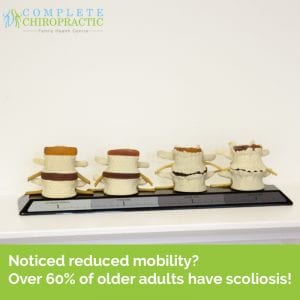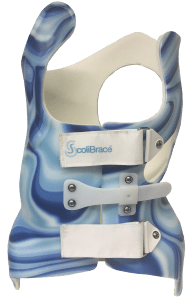This year’s World Spine Day events focused on promoting movement, flexibility and good spinal health in individuals of all ages, if you were involved in any of the events (or even just took some time to think about your own flexibility and ability to move) you might have noticed you were less flexible than you thought! For many older people however, time spent thinking about their spinal health can often lead to the discovery of underlying conditions – this week, let’s look at a common one – adult scoliosis.
Scoliosis in older people
Scoliosis is a condition which was often associated with younger people – and indeed, one which we specialise in treating at our sister clinic, the UK Scoliosis Clinic – but it’s a condition which is especially common in older people. It’s also a condition which often goes unnoticed, and its sometimes only around an event like world spine day that we stop, pause, and really think about some of the symptoms we might be experiencing.
In fact, as many as 1 in 3 people over the age of 60 suffer with Scoliosis – and depending on the severity, the condition can have anything from an uncomfortable impact on mobility, to a life limiting restriction on everyday life.
What are the symptoms of Scoliosis in older people?
Just as with children, the key issue which determines the symptoms experienced is the degree, or severity, of scoliosis. A very small curve may present with few if any symptoms, but, if left untreated, scoliosis can progress to such an extent that normal physical function can be impaired – first making walking and moving about difficult, and then eventually even affecting breathing.
With the message of world spine day in mind, its important to note that many adults simply accept aches and pains as part of “getting older” and in the immediate term the condition may simply be another annoyance, but over time, scoliosis will tend to develop and worsen.
Scoliosis may or may not have a direct impact in terms of pain – but where scoliosis isn’t painful, it may also cause difficulties with movement or a noticeable postural or physical deformation of the spine which for some people can be embarrassing and stressful. The overall result for most older adults is a reduction in their ability or desire to socialise, exercise and get about day to day. This is especially problematic given that research is increasingly showing that keeping fit and active is the key to ageing gracefully and enjoying a long and healthy life.
De-Novo Scoliosis
Whereas younger people tend to suffer with what’s known as “idiopathic” scoliosis, older people are typically diagnosed with “De-Novo” or “new” scoliosis. Unlike scoliosis in juveniles and adolescents (the exact cause of which is still unclear) we do know that De novo scoliosis is caused by wear and tear to the spine. Adults scoliosis is also worsened by wear and tear but is primarily the development of existing scoliosis, rather than an entirely new occurrence. Although the cause might be different, the symptoms are the same – scoliosis sufferers often notice undesirable physical symptoms, such as the Rib cage sticking out on one side, hips or waist sticking out and being unable to stand up straight easily. Scoliosis is also frequently the cause of back pain and discomfort, ranging from moderate to acute. Many suffers also have to live with pain in the legs or pins and needles due to nerve root pressure. That annoying back pain might, in fact, be the early signs of De-Novo scoliosis.
Can scoliosis in adults be treated?
The good news is that through the same treatment approaches which are being used to treat adolescent scoliosis today, its also possible to treat adult scoliosis. Historically, it was thought that only surgical treatment was effective in correcting scoliosis – so with many people unwilling to go under the knife, scoliosis has become a life-limiting factor for many of us. Today, however, conservative methods such as bracing and specialist exercise programs are a time, cost and risk effective way to treat the condition.
For smaller curves, a scoliosis-specific exercise program can be an ideal intervention but by far the best option is a customised scoliosis brace, designed to gently guide the spine back into the proper alignment. Far from the braces used many years ago, our cutting edge ScoliBrace is a low profile, comfortable brace which looks more like a piece of sports equipment than a medical device. Best of all, bracing has been shown to effectively reduce scoliosis and its symptoms, and in some instances can have a noticeable impact in a matter of weeks. Pain especially seems to be reduced through part-time bracing in older adults.
How can I get treatment for scoliosis?
While your GP might be the first stop for most conditions (and its certainly worth a visit to rule out anything more serious) there’s a limited amount that your GP can do for you through the NHS. Instead, consider speaking to your chiropractor – and if you’re a complete chiropractic patient, ask us about our services available through the UK Scoliosis Clinic!

